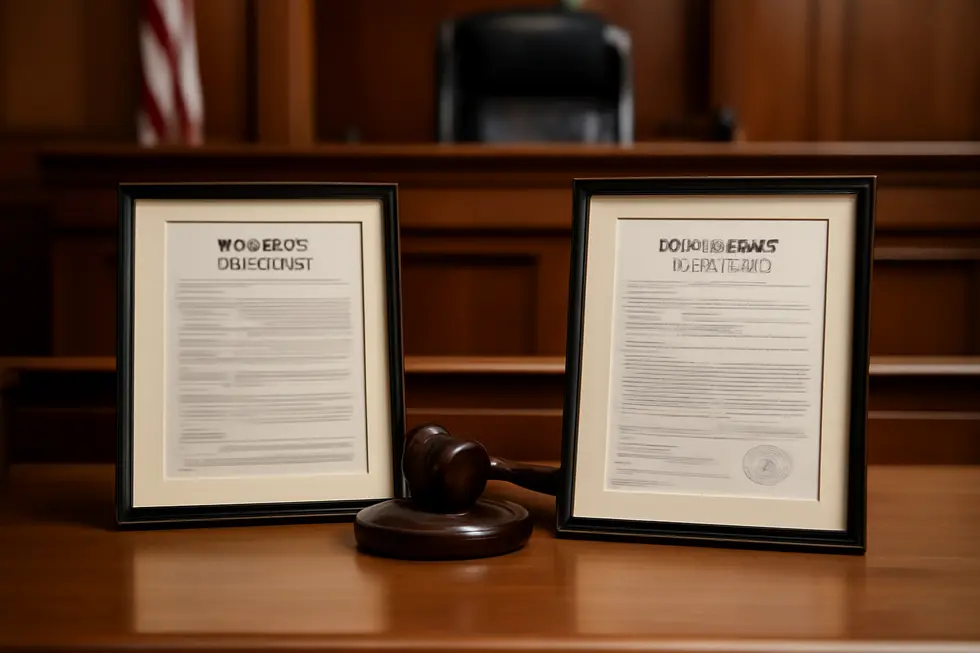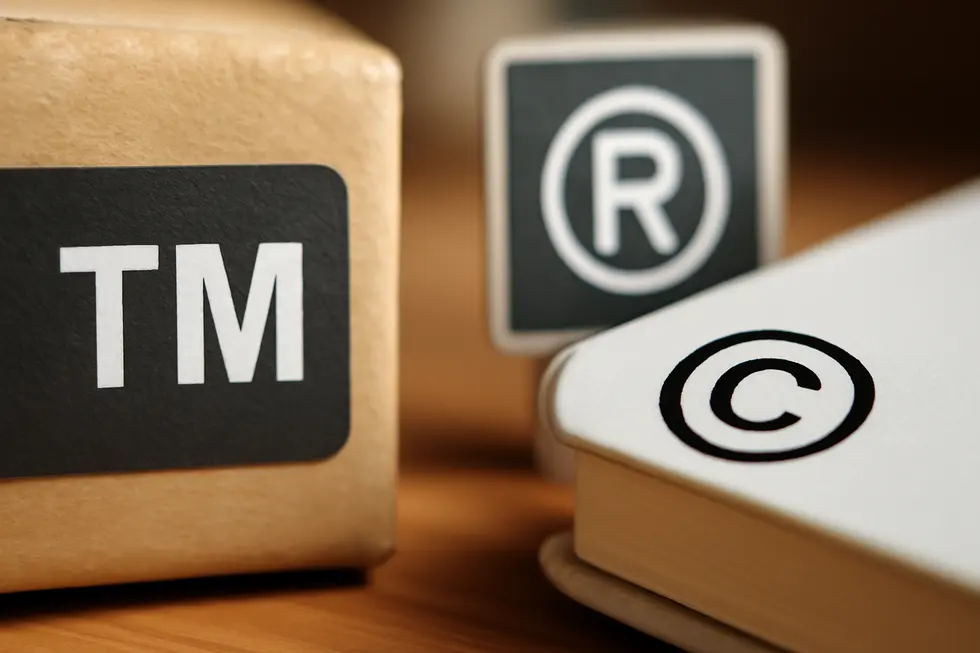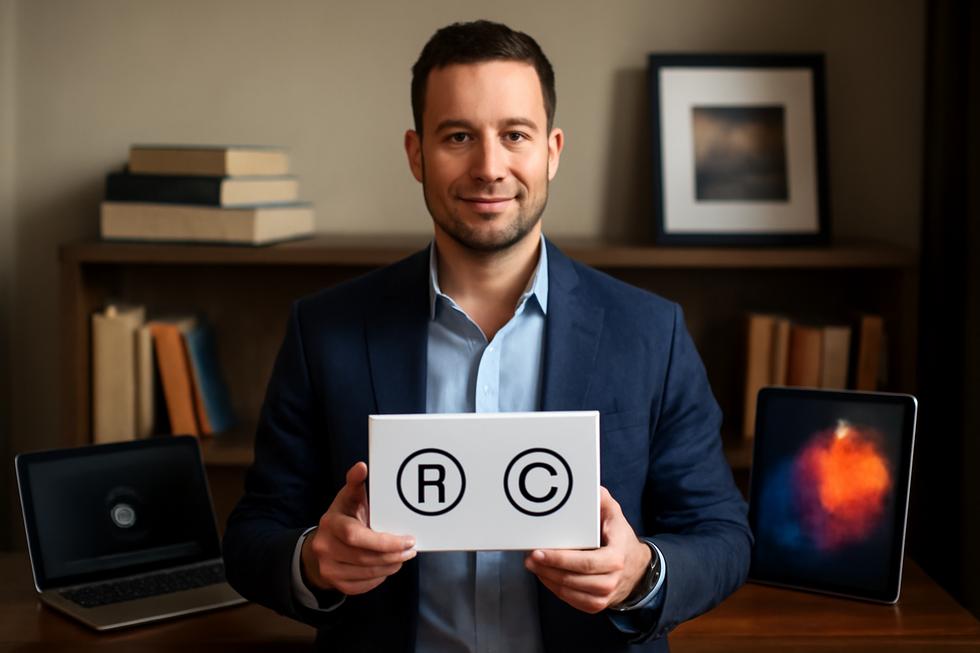Introduction
Protecting intellectual property is vital for every business owner aiming to build lasting value and competitive advantage. Among the most common forms of intellectual property protection, trademarks and copyrights serve distinctly different purposes. Trademarks shield your brand identity—names, logos, and slogans that set your goods or services apart—while copyrights protect your creative works, such as written content, music, and artistic designs. Grasping these differences empowers you to safeguard your business’s unique elements strategically and legally. The following chapters provide an in-depth exploration of how trademarks and copyrights diverge in purpose and scope, duration, legal protections, enforcement, and practical applications, giving you a comprehensive understanding to make informed decisions about your intellectual property assets.
Tables of Contents
Chapter 1: Purpose and Scope: Exploring the difference between trademark and copyright
- Trademark’s Role in Shaping Brand Identity and Market Trust
- Copyright Unveiled: Safeguarding Original Creative Expression Through Legal Protection
Chapter 2: Duration and Term: Key Differences Between Trademark and Copyright Protections
- Indefinite vs. Fixed Terms: How Trademark and Copyright Durations Shape Intellectual Property Protection
- How Protection Terms Shape Economic Value and Cultural Access
Chapter 3: Legal Protection Mechanisms: The difference between trademark and copyright registration and enforcement
- Navigating Registration and Enforcement: Distinct Paths for Trademarks and Copyrights
- Enforcement Strategies and Legal Standards: Navigating Trademark and Copyright Protections
Chapter 4: Infringement and Enforcement: Navigating the difference between trademark and copyright violations
- Trademark Infringement and Enforcement: Protecting Brand Identity Amidst Intellectual Property Challenges
- Unraveling Copyright Infringement and Enforcement in Contrast to Trademark Violations
Chapter 5: Symbols and Notices: Communicating the difference between trademark and copyright status
- Decoding Trademark Symbols (™ , ® , ℠): Clarifying Brand Identity Amid Copyright Protections
- The Copyright Symbol (©): Clarifying Creative Ownership Amid Brand Identifiers
Chapter 6: Practical Examples and Applications: Real-world differences between trademark and copyright in business and creativity
- Harnessing Trademarks for Business Growth: Protecting Brand Identity and Expanding Market Reach
- How Copyright Safeguards Creative Works and Empowers Business Enforcement
Chapter 1: Purpose and Scope: Exploring the difference between trademark and copyright

1. Trademark’s Role in Shaping Brand Identity and Market Trust
A trademark is fundamentally designed to protect the unique identifiers that a business uses to distinguish itself in the marketplace. These identifiers include names, logos, slogans, sounds, colors, and even distinctive packaging, all crafted to signal the source of goods or services to consumers. By safeguarding these elements, trademarks prevent confusion among consumers and help maintain trust in a brand’s authenticity and quality.
The scope of trademark protection is both broad and strategic. It grants the trademark owner exclusive rights to use their marks commercially, enabling businesses to build strong reputations and foster customer loyalty. This protection also plays a crucial role in reducing unfair competition. With trademarks, companies can effectively deter counterfeiters and unauthorized imitators who might exploit a brand’s goodwill for their own gain. As such, trademarks are essential assets that safeguard the investments businesses put into their brand development.
Legal protections for trademarks intensify significantly with federal registration. Registration offers nationwide enforceability, a legal presumption of ownership, and a heightened ability to take action against infringement. Unlike copyrights or patents, which protect creative works or inventions, trademarks focus exclusively on source identifiers that allow consumers to recognize and differentiate products or services in a crowded marketplace.
Through this lens, trademarks act as a reliable communication tool linking consumers to their preferred brands, ensuring that each mark’s uniqueness is preserved. This preservation supports fair competition and maintains the intrinsic value tied to a company’s identity and reputation.
For an in-depth guide on legal protections and strategic use of trademarks, see this detailed resource on trademark protection for business names and logos.
2. Copyright Unveiled: Safeguarding Original Creative Expression Through Legal Protection
Copyright acts as a fundamental legal safeguard for creators by protecting the fixed, tangible expression of original works across diverse media. Unlike trademarks, which shield brand identifiers, copyright’s primary role is to secure authors’ exclusive rights over the unique form their creative ideas take once embodied in a physical or digital medium. This protection extends to a broad spectrum of works including literary compositions, musical pieces, films, software code, and visual arts.
The essence of copyright lies in distinguishing expression from ideas: it covers the specific way thoughts are conveyed but intentionally excludes the underlying concepts or facts to preserve a balance between individual rights and public access. This balance is embedded in the U.S. Constitution’s aim “to promote the progress of science and useful arts” by incentivizing innovation and cultural contribution. Exclusive rights granted to creators cover reproduction, distribution, public performance, derivative adaptations, and translation, empowering them to control how their work circulates and is commercially exploited.
Protection arises immediately when an original work is fixed in a tangible form, without requiring formal registration, although registering copyrights can enhance enforceability and remedies in infringement cases. Importantly, copyright does not extend to abstract ideas, functional objects, or facts, preserving room for ongoing creativity and the free exchange of knowledge.
By granting authors these exclusive rights, copyright encourages the flourishing of arts and sciences while ensuring that, after a limited period, cultural works ultimately enrich the public domain. These principles sharply contrast with trademark’s indefinite protection tied to brand use and consumer recognition, highlighting the distinct but complementary purposes each intellectual property type serves.
For business owners seeking insight into how copyright functions and its implications for creative assets, visiting this comprehensive copyright basics guide offers valuable foundational knowledge.
Chapter 2: Duration and Term: Key Differences Between Trademark and Copyright Protections

1. Indefinite vs. Fixed Terms: How Trademark and Copyright Durations Shape Intellectual Property Protection
Trademarks and copyrights differ significantly in how long they protect intellectual property, reflecting their distinct roles. Trademark protection can last indefinitely, provided the owner actively uses the mark in commerce and meets renewal requirements, typically every 10 years. The continuous use is crucial because failure to use a trademark for a period—usually between three to five years depending on jurisdiction—can lead to abandonment and loss of rights. This ongoing use requirement ensures that trademarks effectively serve their purpose of preventing consumer confusion about the source of goods or services over time.
In contrast, copyright protection has a fixed duration that does not require renewal. Copyright automatically arises the moment an original creative work is fixed in a tangible form. Its term generally lasts for the life of the author plus 70 years, or a fixed 95 years for works created by corporations or anonymous authors. After this period, the work enters the public domain, allowing free use by others without permission or fees. This limited duration balances rewarding creators with promoting access to cultural works.
Unlike trademarks, copyright is not lost through non-use but strictly by the passage of time. Also, copyright registration is optional but often advantageous for enforcement, while trademark rights strongly depend on registration and commercial use to be maintained. This distinction underscores that trademarks protect a brand’s identity and consumer recognition through indefinite legal presence, while copyrights safeguard creative expression temporarily before becoming publicly accessible.
Understanding these timelines helps businesses and creators plan how to protect their assets effectively. For example, while a company logo can be perpetually safeguarded as long as it remains in use and is renewed, a novel or song will only remain protected for the author’s lifetime plus decades thereafter. For more in-depth information on maintaining trademark rights, see the detailed guidance at Trademark protection for business name and logo. External resources outlining these differences further include Wikipedia’s trademark overview.
2. How Protection Terms Shape Economic Value and Cultural Access
Trademark protection stands apart through its potential for indefinite duration. As long as the trademark owner actively uses the mark in commerce and completes timely renewals—typically every ten years—the protections continue. This ongoing safeguarding reflects trademarks’ essential role in maintaining brand identity and consumer trust in the marketplace. If a trademark ceases to be used for a defined period, often three to five years depending on the jurisdiction, it can be deemed abandoned, causing the rights to lapse. This framework incentivizes businesses to sustain reputation and quality over time, supporting brand longevity and market stability.
Copyright protection, by contrast, offers a fixed term rooted in balancing creator incentives with public benefit. Generally lasting for the author’s lifetime plus seventy years, copyright grants exclusive rights to reproduce, distribute, and adapt creative works. For corporate or anonymous authorship, the term extends up to ninety-five years. Unlike trademarks, copyright rights arise immediately upon fixation of the creative work in a tangible form and are not contingent on registration, though registration enhances enforcement capabilities. Once the protected term ends, the work enters the public domain, enriching society by enabling free access and further innovation.
These differing durations have profound economic and societal implications. Indefinite trademark protection fosters continuous brand recognition, which is vital for competition and consumer choice in business. It encourages companies to maintain consistent quality and uphold their reputation over time. Meanwhile, copyright’s limited term balances creators’ ability to profit while eventually allowing creative works to fuel education, culture, and new artistic endeavors. Excessively long copyright terms risk hindering access and slowing innovation, whereas terms too short might reduce creative motivation.
Understanding these contrasting protection durations reveals how intellectual property laws are tailored to distinct purposes—safeguarding commercial identity over indefinite periods while nurturing creative expression within finite terms. This balance shapes both economic strategies and cultural landscapes. For more about trademark protections, see trademark protection for business names and logos.
Further insights into the duration of these protections can be explored at the U.S. Copyright Office.
Chapter 3: Legal Protection Mechanisms: The difference between trademark and copyright registration and enforcement

1. Navigating Registration and Enforcement: Distinct Paths for Trademarks and Copyrights
Trademark and copyright protections serve different legal functions and follow distinct registration and enforcement processes.
Trademarks protect brand identifiers like names, logos, and slogans that set a business apart in commerce. While trademark rights can arise through use (common law rights), they become significantly stronger and more enforceable once federally registered with the U.S. Patent and Trademark Office (USPTO). Registration involves a thorough clearance search to avoid conflicts with existing marks, followed by an application specifying the goods or services covered. Applicants must submit specimens demonstrating actual use of the mark in commerce. The USPTO examines the application and may issue office actions if issues arise, which applicants must address. Before approval, third parties have an opportunity to oppose registration. Once registered, the trademark owner must maintain the registration through timely filings. This process typically costs about $750, including fees for filings and renewals, and takes six to twelve months. Registered trademarks provide public notice of ownership, grant the right to use the ® symbol, and open federal court enforcement options, including customs blocking to prevent counterfeit imports.
In contrast, copyright protection arises automatically the moment an original work is created and fixed in a tangible form, such as literary texts, music, software, or artwork. Registration with the U.S. Copyright Office is not mandatory but offers legal advantages like eligibility for statutory damages and attorney’s fees in infringement actions, greatly strengthening enforcement. Copyright registration requires submitting an application along with a copy of the work. Unlike trademarks, copyright covers the creative expression itself without categorizing by product type, and registration fees are typically lower, around $45 to $65.
Understanding these different registration procedures and enforcement options is critical for businesses and creators aiming to protect their intellectual property effectively. Trademarks secure brand identity in the marketplace through an involved federal registration system, whereas copyrights automatically guard original creative works, with registration acting as an enforcement enhancement. Both protections can intersect—for instance, a logo’s design can be both trademarked for brand use and copyrighted as creative artwork.
For more information on trademark registration procedures and maintenance, see guidance at the Trademark2Go resource. Further details on copyright registration benefits are available from the U.S. Copyright Office.
USPTO Trademark Registration Process
2. Enforcement Strategies and Legal Standards: Navigating Trademark and Copyright Protections
Trademark and copyright enforcement embody distinct legal approaches shaped by the nature of their protected assets. Trademarks safeguard the identity of a brand in commerce, focusing on preventing consumer confusion. Enforcement arises primarily when an unauthorized party uses a mark similar enough to cause confusion about the source of goods or services. Trademark owners must demonstrate this likelihood of confusion, a legal standard that considers the similarity of marks, the relatedness of goods or services, and the strength of the brand. Remedies for infringement include injunctions that stop further use, monetary damages reflecting harm to the brand, and sometimes destruction of infringing goods. Additionally, well-known trademarks receive enhanced protection, defending against dilution even if no direct confusion exists, while defensive marks help extend coverage to related commercial fields.
In contrast, copyright enforcement centers on protecting original creative expressions fixed in a tangible medium—such as books, music, art, or software—rather than ideas or facts themselves. Copyright owners must prove unauthorized copying, distribution, or public use of their specific expression. Legal remedies emphasize deterring infringement through statutory damages, injunctive relief to halt unauthorized use, and sometimes criminal penalties for willful violations. Unlike trademarks, copyright protection automatically arises upon creation, though registration can strengthen enforcement options. The focus is on preserving the creator’s exclusive rights to reproduce, distribute, or publicly display their work.
Together, these enforcement frameworks reflect their distinct goals: trademarks preserve brand reputation and prevent marketplace confusion, while copyright ensures control over creative content. Understanding these standards is essential for effectively protecting intellectual property, whether the asset is a brand element or an original work. For businesses and creators alike, navigating registration and enforcement strategies aligned with these legal principles is vital to safeguarding their intellectual investments.
For deeper insights into trademark protections for brand elements, see this resource on trademark protection for business name and logo.
External Reference: https://ebizfiling.com/blog/copyright-vs-trademark-vs-patent/
Chapter 4: Infringement and Enforcement: Navigating the difference between trademark and copyright violations

1. Trademark Infringement and Enforcement: Protecting Brand Identity Amidst Intellectual Property Challenges
Trademark infringement arises when someone uses a trademark identical or confusingly similar to a registered mark on related goods or services. This usage leads to consumer confusion about the source or endorsement of those goods. To establish infringement, the trademark owner must prove ownership of a valid mark, priority of rights over the infringer, and a likelihood of confusion. Unlike copyright infringement—which centers on improper copying of original creative expression—trademark infringement focuses on safeguarding brand identifiers that ensure consumers recognize authentic products or services.
Trademark enforcement requires diligent, ongoing action by the owner to preserve exclusivity. This includes monitoring unauthorized uses, issuing cease-and-desist letters, and initiating legal proceedings when necessary to prevent dilution or tarnishing of the brand’s reputation. Continuous maintenance of trademark registrations and opposition to conflicting marks at the trademark office is also vital for sustaining rights. Defenses against infringement claims typically involve fair use, such as using a mark descriptively or simply to refer to the trademark owner without implying sponsorship.
The fundamental goal of trademark enforcement is to prevent consumer confusion and protect the brand’s goodwill in the marketplace. This contrasts with copyright enforcement, which concentrates on stopping unauthorized reproduction or distribution of original works like music, books, or software. Where copyright begins protection automatically upon creation, trademark rights heavily rely on registration and active defense, underscoring the importance of strategic brand management.
Understanding these distinctions is crucial for businesses to craft targeted legal strategies. Proper trademark enforcement not only shields a company’s identity but also bolsters consumer trust and market position. For a deeper understanding of trademark protection mechanisms and enforcement tactics, visit this comprehensive resource on trademark protection for business names and logos. For further authoritative insights into the nature of trademark infringement and defenses, Wikipedia’s trademark page offers detailed explanations.
2. Unraveling Copyright Infringement and Enforcement in Contrast to Trademark Violations
Copyright infringement occurs when a protected creative work is copied, distributed, performed, or displayed without the copyright holder’s permission. This includes unauthorized use of music, literature, films, artworks, or software. Acts such as verbatim copying, unauthorized translation, or sharing works online without consent all constitute infringement. To establish a legal claim, the copyright owner must prove ownership, unauthorized use, and substantial similarity between their original work and the infringing one. Enforcement often begins with cease and desist letters and may escalate to formal litigation or DMCA takedown notices to prevent further unauthorized distribution.
In contrast, trademark infringement focuses on protecting brand identifiers like logos, names, or slogans that uniquely signal the source of goods or services. Infringement arises when an unauthorized use causes consumer confusion about the origin of products. Trademark rights stem from use in commerce or registration, and enforcement aims primarily to preserve brand identity and trust. Remedies typically include injunctions, monetary damages, and destruction of counterfeit items. Unlike copyright, success in trademark claims hinges on demonstrating a likelihood of confusion rather than copying per se.
A critical distinction between these intellectual property protections lies in their subject matter and infringement focus. Copyright safeguards the creator’s original expression, shielding it from direct or derivative copying. Trademark protects the brand’s identity, focusing on consumer perception and preventing misleading associations. Duration also differs, with copyright lasting the author’s life plus decades, while trademarks can last indefinitely with continuous use and renewal.
Both areas recognize contributory liability, holding third parties accountable if they knowingly facilitate infringement, such as online platforms hosting unauthorized content or sellers distributing counterfeit goods. Enforcement processes differ accordingly: copyright holders may rely on statutory takedown procedures like DMCA, whereas trademark owners use administrative proceedings through the USPTO and civil litigation to protect their marks.
Grasping these differences is essential for correctly enforcing intellectual property rights and addressing infringement claims. For further insights into trademark’s role in protecting brand elements, see this detailed discussion on trademark protection for business names and logos.
External resource on copyright infringement claims: What is a Copyright Infringement Claim? – Lumenci
Chapter 5: Symbols and Notices: Communicating the difference between trademark and copyright status

1. Decoding Trademark Symbols (™ , ® , ℠): Clarifying Brand Identity Amid Copyright Protections
Trademark symbols such as ™, ℠, and ® serve as powerful visual notices that communicate the legal status of brand identifiers in commerce. These marks distinguish trademarks—names, logos, and slogans that identify goods or services—from copyrighted creative works, which are signified by the © symbol. Understanding these distinctions is essential for protecting intellectual property effectively and avoiding confusion between brand ownership and creative content rights.
The ™ symbol signals an unregistered trademark for goods, indicating that a claim to the brand element is made but official registration has not yet been secured. While ™ does not guarantee full legal protection, it notifies competitors and consumers that the mark is actively claimed, helping establish common law rights through use. Similarly, the ℠ symbol specifically applies to unregistered service marks, which identify services rather than tangible products. It functions like ™ by marking a service-related brand claim without registration but with limited legal enforcement.
In contrast, the ® symbol denotes a trademark or service mark that has successfully completed the formal registration process with a governmental trademark office, such as the USPTO in the United States. Using ® communicates a stronger legal status, granting the owner widespread protection and enforcement capabilities against infringement and counterfeit use. Importantly, improper use of ® before registration is unlawful and can lead to penalties.
To clarify, copyright protection automatically attaches upon creation of original works that are fixed in a tangible medium, covering artistic, literary, musical, and software expressions rather than brand identifiers. The © symbol serves to mark these creative works and inform the public of copyright status, but it does not apply to trademarks or branding concepts.
Correct application of trademark symbols educates consumers and competitors alike, signaling whether a brand element enjoys registered protection or simply a claim based on use. For example, a new product’s logo might be marked with ™ initially, then updated to ® after registration, while service providers use ℠ and ® similarly. This transparent communication is key to maintaining legal clarity and safeguarding brand reputation.
For businesses, distinguishing trademark symbols from copyright marks is crucial in protecting brand identity and creative assets appropriately, mitigating risks of infringement or misrepresentation. Detailed guidance on these symbols and their legal implications is available on authoritative sites such as the Wikipedia trademark page, which elaborates on their proper usage and protection levels.
Further insights on trademark protection strategies can be found at Trademark Protection for Business Name and Logo.
2. The Copyright Symbol (©): Clarifying Creative Ownership Amid Brand Identifiers
The copyright symbol (©) serves as a clear and direct notice that a work is protected under copyright law, which safeguards original creative expressions such as books, music, artwork, and software. When this symbol appears alongside a work, it signals that the creator holds exclusive rights to reproduce, distribute, display, or perform the work, establishing ownership over the expression embodied in tangible form. Importantly, this protection applies strictly to the creative content itself, not to names, logos, or slogans that identify a source in commerce.
In contrast, trademarks focus on protecting brand identity elements—words, phrases, logos, or designs—that distinguish goods or services in the marketplace. Here, symbols like ™ and ® communicate trademark claims; ™ indicates a claimed but unregistered trademark, while ® denotes a federally registered trademark providing nationwide legal protection. These symbols inform the public and competitors about the legal status of a brand identifier but do not relate to the underlying creative content.
This differentiation of symbols plays a vital role in reducing confusion about the nature and scope of intellectual property rights. The © symbol alerts users and potential infringers that the rights cover the creative work, setting clear boundaries against unauthorized copying or adaptation. Meanwhile, trademark symbols specify protection tied to brand source and reputation, focusing on preventing consumer confusion rather than guarding creative expression.
For creators and businesses alike, understanding the © symbol’s role within this context ensures accurate communication of intellectual property status. It helps preserve the integrity of original works while distinguishing them from branding elements governed by trademark law. This nuanced symbolic language ultimately supports effective rights enforcement and clearer public awareness.
For a comprehensive explanation of trademark versus copyright symbols and their impact, see the detailed discussion by NameStormers and the informative insights on Trademark2Go.
Chapter 6: Practical Examples and Applications: Real-world differences between trademark and copyright in business and creativity

1. Harnessing Trademarks for Business Growth: Protecting Brand Identity and Expanding Market Reach
Harnessing Trademarks in Business for Brand Protection and Market Expansion
Trademarks serve as indispensable instruments for businesses to protect their brand identity and foster market growth. These marks—comprising names, logos, slogans, or even unique packaging—function as identifiers that distinguish goods or services in commerce. Their legal protection deters competitors from using similar marks that could mislead or confuse consumers, preserving the original brand’s reputation and consumer loyalty.
Businesses typically apply trademarks visibly on products, labels, packaging, or marketing materials such as websites and advertisements. This consistent, public use in regulated commerce establishes and reinforces brand recognition. Furthermore, registering trademarks provides exclusive legal rights that enable owners to enforce protections against unauthorized use, strengthening their market position.
Beyond legal safeguards, trademarks contribute significant intangible value to a business. They create customer trust and brand loyalty, making marketing efforts more efficient and impactful. This recognition can translate into asset value, as trademarks often become licensable or saleable properties, generating additional revenue streams. Trademark protections also facilitate entry into new markets or countries through international agreements, broadening a company’s expansion opportunities.
For example, a company developing distinct product packaging coupled with a carefully registered trademark can leverage this cohesive brand identity when launching new product lines. Licensing deals under the same trademark can extend reach and generate income while maintaining control over brand use. Early registration of trademarks, often advised with legal assistance, ensures solid protection and long-term benefits.
In sum, trademarks play a strategic role not only in defending brand uniqueness but also as active drivers behind marketing success and business growth. For businesses seeking comprehensive guidance on trademark protection, resources such as trademark protection for business name and logo provide valuable insights on securing and maximizing these critical assets.
2. How Copyright Safeguards Creative Works and Empowers Business Enforcement
Copyright protection serves as a legal shield for creators by granting exclusive rights over original works fixed in a tangible medium. This encompasses an extensive range of creative outputs such as books, music, films, visual art, and software. The moment an idea is expressed and recorded—whether written, composed, painted, or coded—it automatically gains copyright protection without needing registration, although formal registration strengthens enforcement capabilities.
For instance, literary works like novels and articles cannot be copied or distributed without the author’s permission, preserving their value and integrity. Similarly, musical compositions and recordings enjoy protection against unauthorized reproduction, ensuring composers and performers retain control over their creations. Visual arts, including paintings, photography, and digital graphics, are shielded from illicit use or replication, maintaining an artist’s exclusive rights. In fast-paced industries such as software development and digital media, copyright safeguards computer code and multimedia content, which is vital for innovation and commercial viability.
Enforcement mechanisms are rigorous to deter infringement and protect economic interests. When a work is registered, creators can seek civil remedies like injunctions to halt violations, recover statutory damages ranging from $750 up to $150,000 for willful violations, and claim profits wrongfully earned by infringers. Additionally, criminal penalties can apply for large-scale, deliberate infringement, including fines up to $250,000 and imprisonment for up to 10 years. Businesses strategically enforce copyright to prevent piracy, maintain competitive advantage, and support sustainable creative industries.
Copyright infringement examples include exact copying without authorization, unauthorized online sharing of movies or music, and translating a work without permission. These actions violate exclusive rights legally reserved for the creator. Understanding these protections helps businesses and artists defend their work and monetize their original creations effectively.
For those seeking further guidance on copyright frameworks and enforcement, reputable resources such as Interjustice Law Firm provide detailed insights into infringement cases and legal remedies.
For a deeper understanding of copyrights relevant to business and creative efforts, see this detailed copyright information example for business.
Final thoughts
Understanding the distinct roles of trademarks and copyrights is pivotal for business owners seeking to protect their most valuable assets. Trademarks safeguard your brand’s identity, helping consumers recognize your goods and services and distinguishing you in the marketplace, while copyrights secure the creative expressions—text, music, art—that infuse your business with originality and value. Recognizing their differences in purpose, scope, duration, legal procedures, and enforcement allows you to strategically manage your intellectual property portfolio. By leveraging both forms of protection effectively, you can defend your brand reputation, prevent unauthorized use, and ensure your creative contributions remain rightfully yours — key steps toward long-term business success and sustainability.
Your IP is the foundation of your success – let’s protect it together before it’s too late. We can’t wait to help you turn your ideas into legally secured assets.
About us
undefined



Your point of view caught my eye and was very interesting. Thanks. I have a question for you. https://accounts.binance.info/lv/register-person?ref=SMUBFN5I